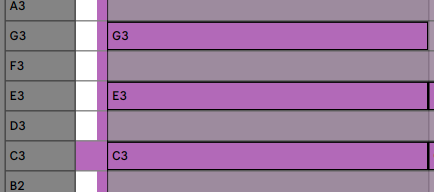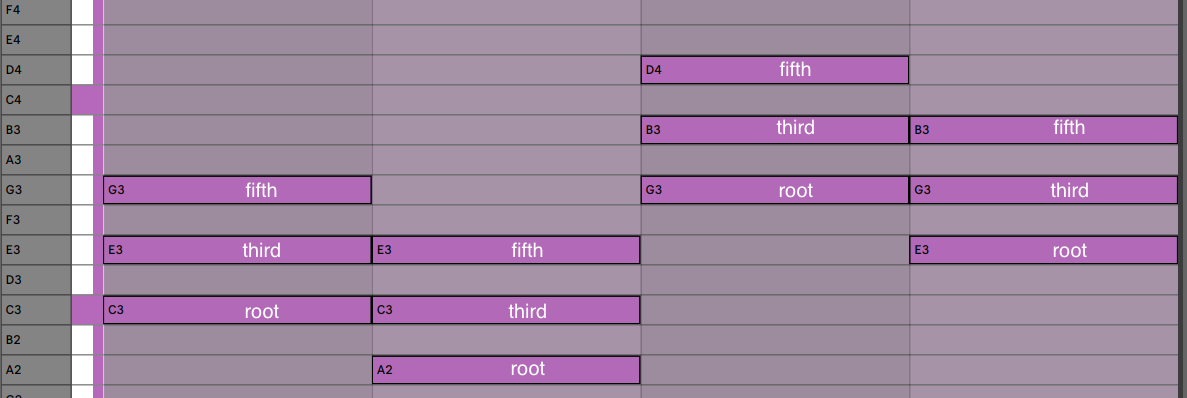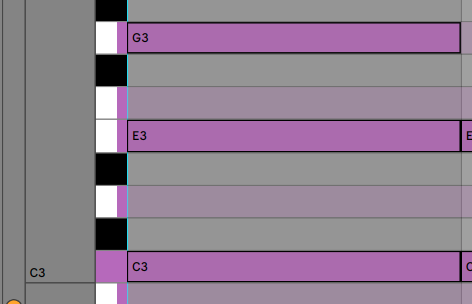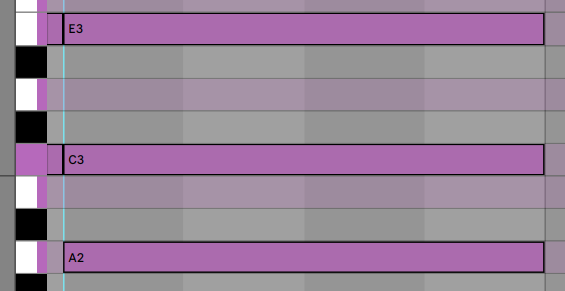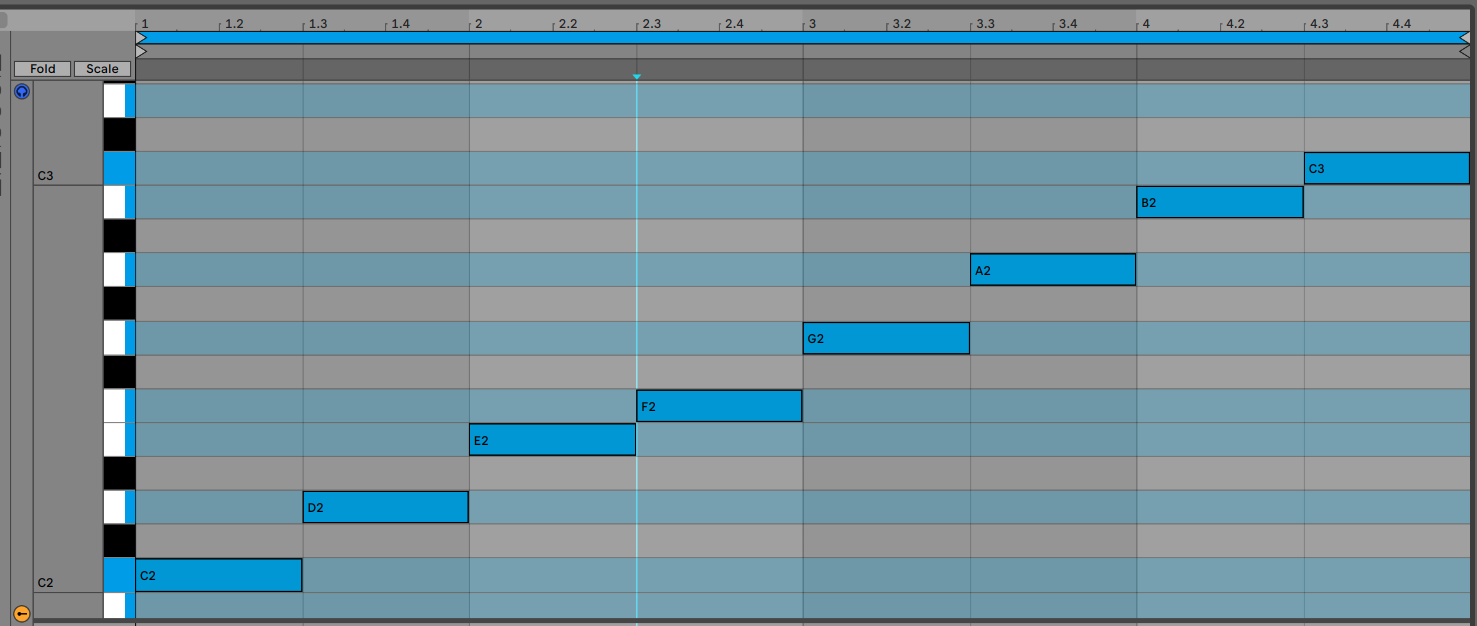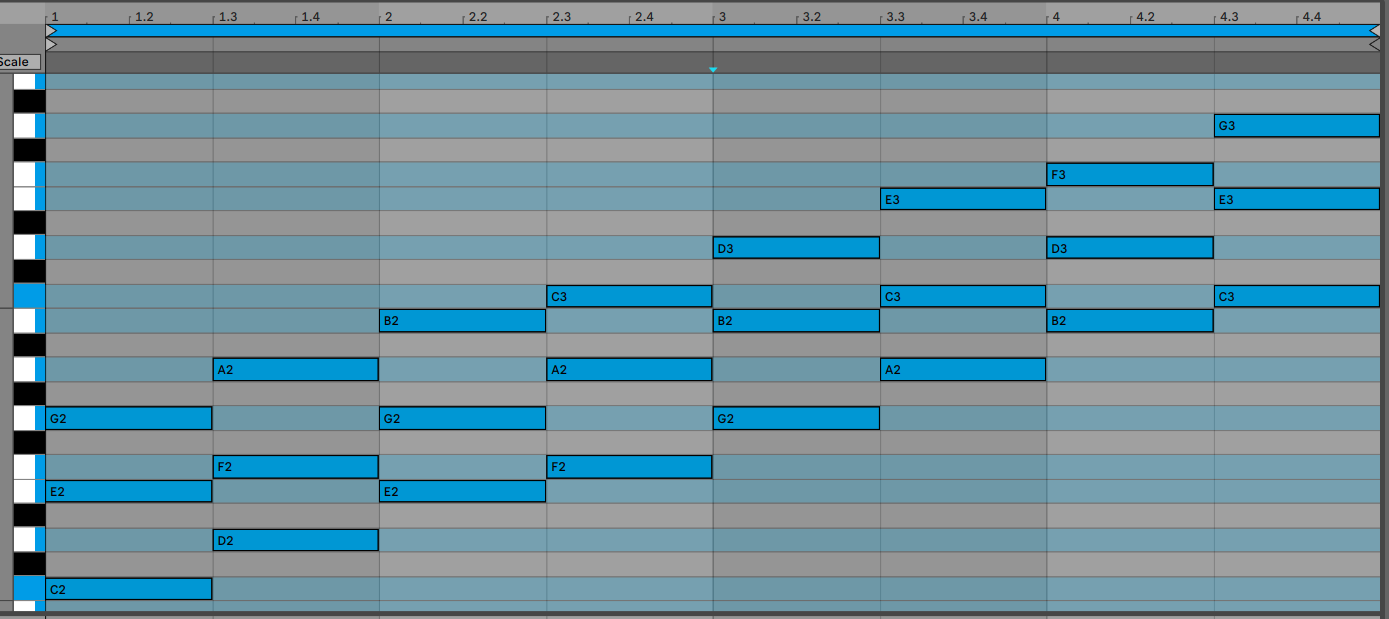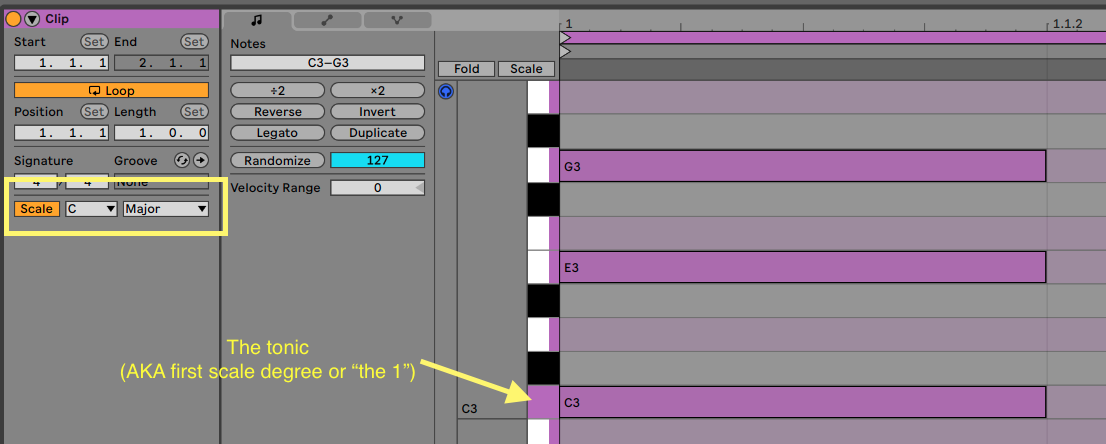Part 3 - Tonal music theory basics: notes, scales, and chords
Instructions: Select a step from the menu on the left.
| Note names |
Please watch the video below (it may take a moment to load) |
| Scales / Key Signatures |
Note that this resource was made in Live 10 before some of the new scale highlighting features were added in Live 11, more on that feature in some of the later resources. |
| What are chords |
What are chords? Chords are when three or more notes are playing at the same time, also known as a "harmony".
|
| Making chords (including the "cheater's guide") |
How do I make chords?Make any three notes play at the same time and that's a chord! You probably want to have three notes playing at the same time that are from your scale. Using Ableton Live 11's scale highlighting and scale folding feature, that's pretty easy:
The cheater's guide
|
| Understanding triads |
What sort of chords are these?The three note chords you will make following the "cheater's guide" are "triads". Those are standard three note chords (hence, tri) that are important building blocks for understanding harmony.What do I call each of the notes in the chord?
However in the context of a chord, each of these notes has a certain standard title:
Why third and fifth? What happened to second and fourth? Well the second and fourth are the notes that we skipped when following the cheaters guide! Note that it doesn't matter what triad you've got and what notes from the scale it uses, in the context of any individual standard triad we will call the three notes that it uses the root, third and fifth.
|
| Naming chords - Standard names |
What do I call the actual chord I just made?
Chords can be named in a few different ways, and it relates to the intervals (i.e. distance between the notes) that are being used. Let's look at the first chord this example more closely. This time I've turned scale fold off so we can see all of the notes of the piano.
Our root is really important here, that's the "tonal centre" of the chord. We want to measure the distance between our root and the other notes to learn about what sort of chord structure we have. In this case:
Consequently we can call this chord a "C major chord". That means the root is C, and it has a major third. Compare that to this chord:
In this case:
Consequently we can call this an "A minor chord". The root is the note A and it contains a minor third. What about the fifth, does that not matter?In both cases the fifth was present and seven semitones above the root. The fifth has a really "stable" relationship with the root, so much so it's almost hard to tell whether or not it's present. Try playing these chords with and without the fifth, you'll find that they don't change heaps. However the fifth is a nice complimentary ingredient to include, so we often do!I often like to think of the analogy of ingredients/cooking when thinking about music theory. When it comes to chords, the third is a really prominent stand out ingredient. If you change from a major third to a minor third, it totally changes the dish. However the fifth is something complimentary like a little extra salt and pepper. It doesn't change the dish, but it is nice to have. |
| Harmonising the scale + the diminished chord |
Harmonising the scaleIf we were to write out all the notes of a scale in an ascending order, it might look something like this example (done in the C major scale):
If we were to follow the cheater's guide to quick chords to add the necessary third and fifth to each chord, it would look like this:
The advantage of doing this, is we now know all of the standard triads that are available in the scale! The diminished chordHarmonising the scale has created a series of different major and minor chords, but also one chord that's a bit different. Can you see which? It's the second from the right, with the note B as it's root.
This chord has:
We call this a "diminished chord". Diminished chords have a minor third but the special flattened five makes it "diminished". Diminished chords create a lot of tension which is a powerful tool in composition. This is another example of a type of chord, each of which are defined by the intervals they used. Now we've talked about three, major chords, minor chords and diminished chords. There are more but plenty of hit songs are written using only this small set. |
| Naming chords - In a scale context |
Are there any other names for chords?Whilst it will pretty much always be appropriate to call this chord C major, there might be some other names for the chord if we need to think about it in different contexts. E.g. Whilst calling it "the C major chord" isn't wrong, it doesn't tell us much about how the chord is being used in the song or scale.
Another way we can name chords is by referring to the "scale degree" of their root. Scale degrees are just numbers assigned to each note of the scale, starting with 1 for the tonic and going up as you move away from the tonic. So if I was writing in the C major scale, this C major chord could be called "the 1 chord" to reference that it's the standard triad built off of the first scale degree.
However if I was writing in the F major scale, we could call it "the five chord" in reference to being built off of the fifth scale degree. Note that each time the chord was C major and the only thing that changed was what scale we were using (so you would need both bits of information, the scale and the chord name in this number format).
Why name chords this way?Because it allows us to think about chord progressions not so much just as static sets of notes, but rather how they use the scale. A C major chord will feel very different when used in a song that's in C major vs. a song that's in F major. It also allows us to see common patterns that are used even across different scales. If you choose a major scale and write out this chord progression (using each number as the scale degree of a root then constructing standard triads), see if it sounds familiar to you: 1 - 5 - 6 - 4 It should sound familiar, as that's the most common chord progression in modern pop music! But it's not always in the same scale each time, though the general feeling of the chord progression is always similar. The distance between the notes and the movement from chord to chord often matters a lot more to the feeling of the song than the proper names of any of the chords used. |
| Naming chords - Roman numeral analysis |
How can I write the "in scale context" names in shorthand?There is a system for writing out in scale context names using roman numerals, often referred to as "roman numeral analysis". Roman numerals are often seen on posters for movies/game sequels, such as "V" for five and "X" for ten. We use roman numerals in music to indicate referring to a chord by the scale degree of its root. It also provides some added information by whether or not the roman numeral is capitalised. If it's capitalised, it's a major chord. If it's lowercase it's a minor chord. So for example: I - V - vi - IV Would be the same as "1 - 5 - 6 - 4" but by seeing roman numerals you know for sure we are referring to a chord progression and you can even tell which chords are major or minor triads. If we follow the process of harmonising a major and minor scale as we did before but then split each chord into a new clip, which we rename with the appropriate roman numeral, we would get the following:
Note that the diminished chord is lowercase (because it does have a minor third) but also has the added ° symbol (on a mac press opt + shift + 8) to indicate that it's diminished (i.e. has the flattened fifth). One of the other reasons it's useful to have roman numeral analysis is because there are a lot of numbers in music. E.g. time signatures, rhythmic subdivisions, scale degrees, intervals and so on. Having a different writing scheme from regular arabic numerals makes it easier at a glance to know we are specifically referring to chords. |
| Test your knowledge quiz |
Have a go at the following quiz to test your knowledge about these concepts |


